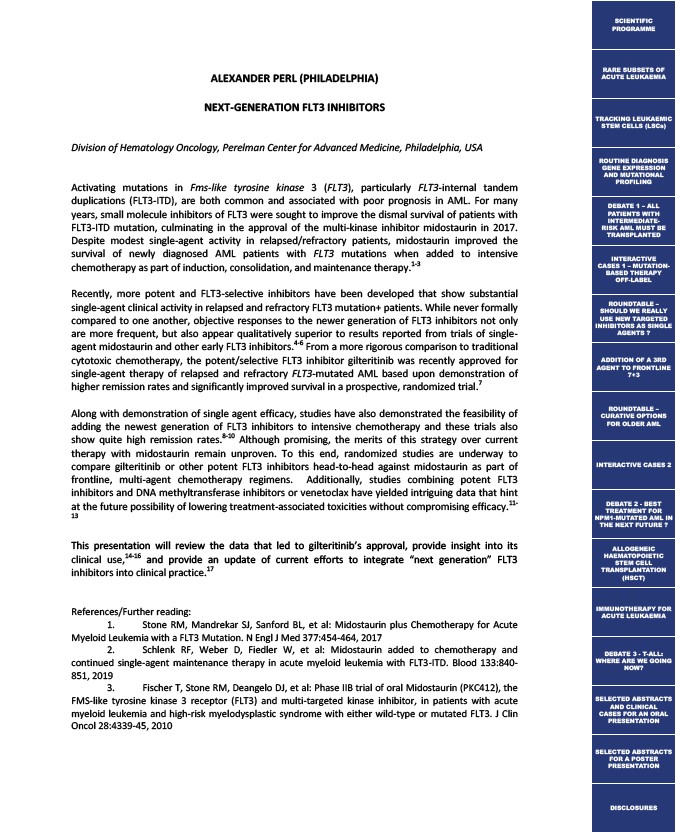
ALEXANDER PERL (PHILADELPHIA)
NEXT-GENERATION FLT3 INHIBITORS
Division of Hematology Oncology, Perelman Center for Advanced Medicine, Philadelphia, USA
Activating mutations in Fms-like tyrosine kinase 3 (FLT3), particularly FLT3-internal tandem
duplications (FLT3-ITD), are both common and associated with poor prognosis in AML. For many
years, small molecule inhibitors of FLT3 were sought to improve the dismal survival of patients with
FLT3-ITD mutation, culminating in the approval of the multi-kinase inhibitor midostaurin in 2017.
Despite modest single-agent activity in relapsed/refractory patients, midostaurin improved the
survival of newly diagnosed AML patients with FLT3 mutations when added to intensive
chemotherapy as part of induction, consolidation, and maintenance therapy.1-3
Recently, more potent and FLT3-selective inhibitors have been developed that show substantial
single-agent clinical activity in relapsed and refractory FLT3 mutation+ patients. While never formally
compared to one another, objective responses to the newer generation of FLT3 inhibitors not only
are more frequent, but also appear qualitatively superior to results reported from trials of single-agent
midostaurin and other early FLT3 inhibitors.4-6 From a more rigorous comparison to traditional
cytotoxic chemotherapy, the potent/selective FLT3 inhibitor gilteritinib was recently approved for
single-agent therapy of relapsed and refractory FLT3-mutated AML based upon demonstration of
higher remission rates and significantly improved survival in a prospective, randomized trial.7
Along with demonstration of single agent efficacy, studies have also demonstrated the feasibility of
adding the newest generation of FLT3 inhibitors to intensive chemotherapy and these trials also
show quite high remission rates.8-10 Although promising, the merits of this strategy over current
therapy with midostaurin remain unproven. To this end, randomized studies are underway to
compare gilteritinib or other potent FLT3 inhibitors head-to-head against midostaurin as part of
frontline, multi-agent chemotherapy regimens. Additionally, studies combining potent FLT3
inhibitors and DNA methyltransferase inhibitors or venetoclax have yielded intriguing data that hint
at the future possibility of lowering treatment-associated toxicities without compromising efficacy.11-
13
This presentation will review the data that led to gilteritinib’s approval, provide insight into its
clinical use,14-16 and provide an update of current efforts to integrate “next generation” FLT3
inhibitors into clinical practice.17
References/Further reading:
1. Stone RM, Mandrekar SJ, Sanford BL, et al: Midostaurin plus Chemotherapy for Acute
Myeloid Leukemia with a FLT3 Mutation. N Engl J Med 377:454-464, 2017
2. Schlenk RF, Weber D, Fiedler W, et al: Midostaurin added to chemotherapy and
continued single-agent maintenance therapy in acute myeloid leukemia with FLT3-ITD. Blood 133:840-
851, 2019
3. Fischer T, Stone RM, Deangelo DJ, et al: Phase IIB trial of oral Midostaurin (PKC412), the
FMS-like tyrosine kinase 3 receptor (FLT3) and multi-targeted kinase inhibitor, in patients with acute
myeloid leukemia and high-risk myelodysplastic syndrome with either wild-type or mutated FLT3. J Clin
Oncol 28:4339-45, 2010
SCIENTIFIC
PROGRAMME
RARE SUBSETS OF
ACUTE LEUKAEMIA
TRACKING LEUKAEMIC
STEM CELLS (LSCs)
ROUTINE DIAGNOSIS
GENE EXPRESSION
AND MUTATIONAL
PROFILING
DEBATE 1 – ALL
PATIENTS WITH
INTERMEDIATE-RISK
AML MUST BE
TRANSPLANTED
INTERACTIVE
CASES 1 – MUTATION-BASED
THERAPY
OFF-LABEL
ROUNDTABLE –
SHOULD WE REALLY
USE NEW TARGETED
INHIBITORS AS SINGLE
AGENTS ?
ADDITION OF A 3RD
AGENT TO FRONTLINE
7+3
ROUNDTABLE –
CURATIVE OPTIONS
FOR OLDER AML
INTERACTIVE CASES 2
DEBATE 2 - BEST
TREATMENT FOR
NPM1-MUTATED AML IN
THE NEXT FUTURE ?
ALLOGENEIC
HAEMATOPOIETIC
STEM CELL
TRANSPLANTATION
(HSCT)
IMMUNOTHERAPY FOR
ACUTE LEUKAEMIA
DEBATE 3 - T-ALL:
WHERE ARE WE GOING
NOW?
SELECTED ABSTRACTS
AND CLINICAL
CASES FOR AN ORAL
PRESENTATION
SELECTED ABSTRACTS
FOR A POSTER
PRESENTATION
DISCLOSURES